A choice of any fly depends on what trout are actively feeding on and the fishing gear used.
Fishing with Spey gear is most effective on flowing water with decent numbers of trout or when prospecting large bodies of moving water with low amounts of aggressive ‘piscivorous’ fish - fish eating other fish. In New Zealand, this usually means fishing lowland rivers, as well as rivers and estuaries receiving runs of fish from lakes or the ocean.
Flies for Trout Spey can be divided into three broad categories: dry flies, emergers (soft hackles and some winged wet flies), and streamers. In this article I discuss the designs I’ve found especially effective in New Zealand, as well as the gear I use and the techniques for fishing them.
Dry flies
Dry flies for Trout Spey are typically fished on the swing, and usually imitate newly-emerged or egg-laying caddis flies when scuttling or fluttering across the surface on dusk.
Some anglers use Trout Spey gear to fish traditional dry flies dead drift but overhead casting with a single hand rod and a regular fly line is far more effective, especially in New Zealand.
Many New Zealand lowland rivers have good summer caddis hatches that begin at dusk and continue for an hour or so after dark. The insects responsible for these hatches are usually net-spinning caddisflies, around a size 12.
A dry fly I’ve found especially effective for swinging during caddis hatches is a foam fly I’ve designed and called the ‘Scuttling Caddis’. The Scuttling Caddis has a realistic profile, never becomes water logged, doesn’t require false casting to dry it and is indestructible regardless the amount of fish caught on it.
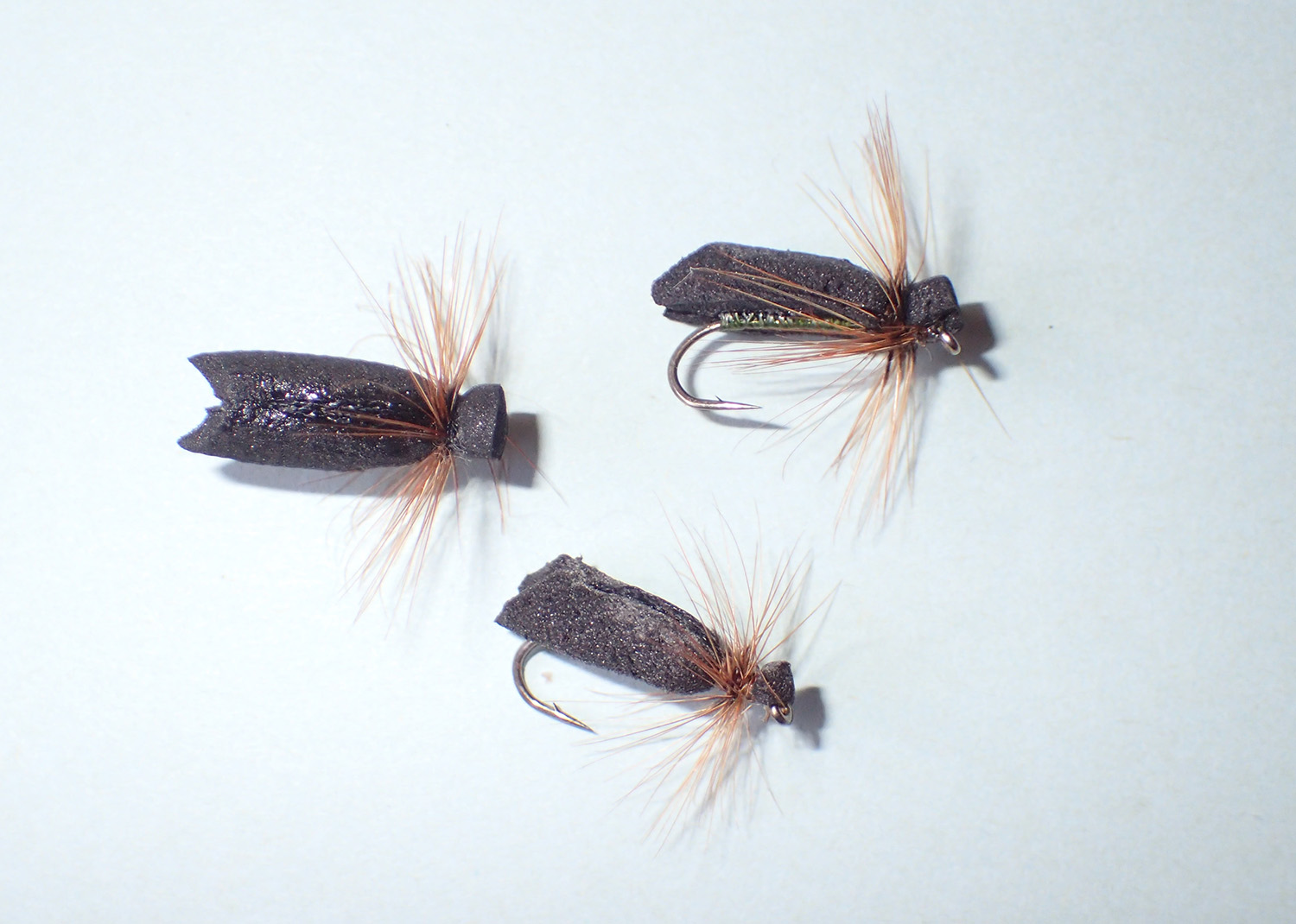
The Scuttling Caddis
Tying The Scuttling Caddis
I tie the Scuttling Caddis on a 2x long shank hook, like a Kamasan 830 or TMC 5262. The foam wing is shaped from a foam cylinder and kept in place with a piece of 1/16 inch flat braid coated with super glue.
Fishing the Scuttling Caddis
I fish the Scuttling Caddis on the dropper with a Caddis emerger (see next section - Emergers) attached to the bend with two feet of tippet. The tippet needs to be fairly stout to prevent break-offs and flies tangling. I like 6 lb Maxima tippet, but 3X Fluorocarbon also works well.
I cast the tandem rig across or down-and-across, using cast angles and mends to match the speed of the swinging fly with the speed of natural caddis flies scuttling across the surface.
Emergers
Fishing emergers is a great way to catch rising fish with Trout Spey gear.
In New Zealand, surface hatching insects attracting rising fish are usually small to medium clinger mayflies (#18-16) or medium sized caddis flies (#12). Both these groups of insects swim to the surface to hatch, but the caddis pupae are more active swimmers than the surface-hatching mayflies. New Zealand has several species of large swimming mayflies but the nymphs crawl onto the shore before hatching and are more likely to be found in the headwaters.
Emerger patterns suitable for Spey gear mostly consist of soft hackles and some winged wet flies.
Stewart-style spiders - a style of soft hackle developed by Scotsman WC Stewart in the mid-1800s - make great imitations of small emerging mayflies. This simple design consists of a thin body of thread, fine dubbing or tinsel and a soft hackle palmered through the front third of the shank.
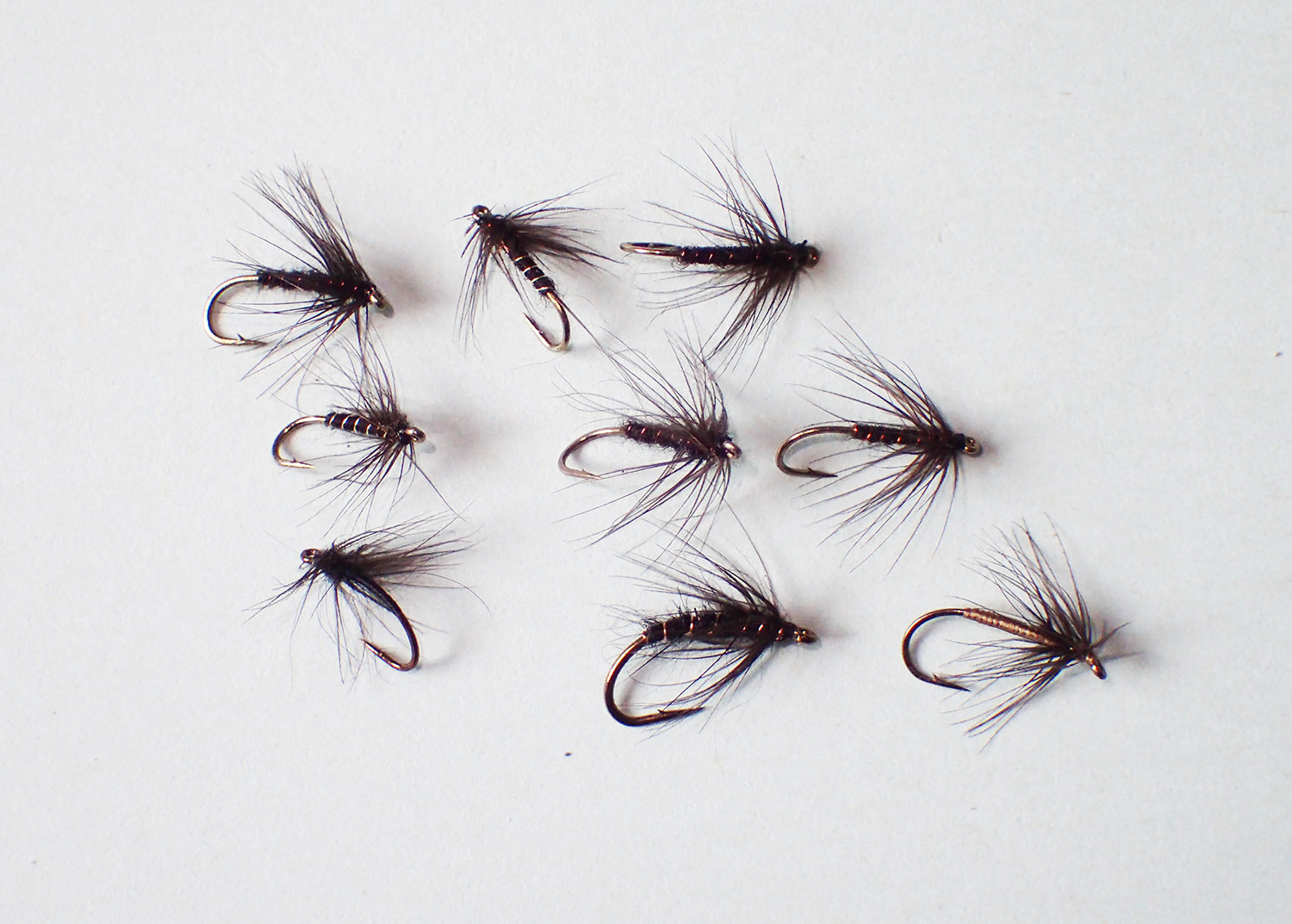
Examples of Stewart-style spiders designed imitate mayfly emergers (sizes 18 - 14)
Spiders are most effective when cast up-and-across or directly across and presented broadside to the fish with as little drag as possible. The movement produced by the soft hackle fibres dancing on the current or twitched by an occasional mend, are enough to imitate an emerging mayfly rising just below the surface. A very slow swing is also effective at times, especially at the end of the drift.
Winged wet flies do a good job of imitating emerging caddisflies.
The Possum Caddis is a pattern I designed and honed over several years on the Tongariro River, where it regularly out-fishes just about any other fly during the evening caddis hatch. Not your traditional wee wet fly, the Possum Caddis has a fat hare’s ear abdomen, a possum fur wing, and hackle of medium stiff rooster to imitate active legs. Soft hackle collapses when swung across currents so it doesn’t provide the movement required.
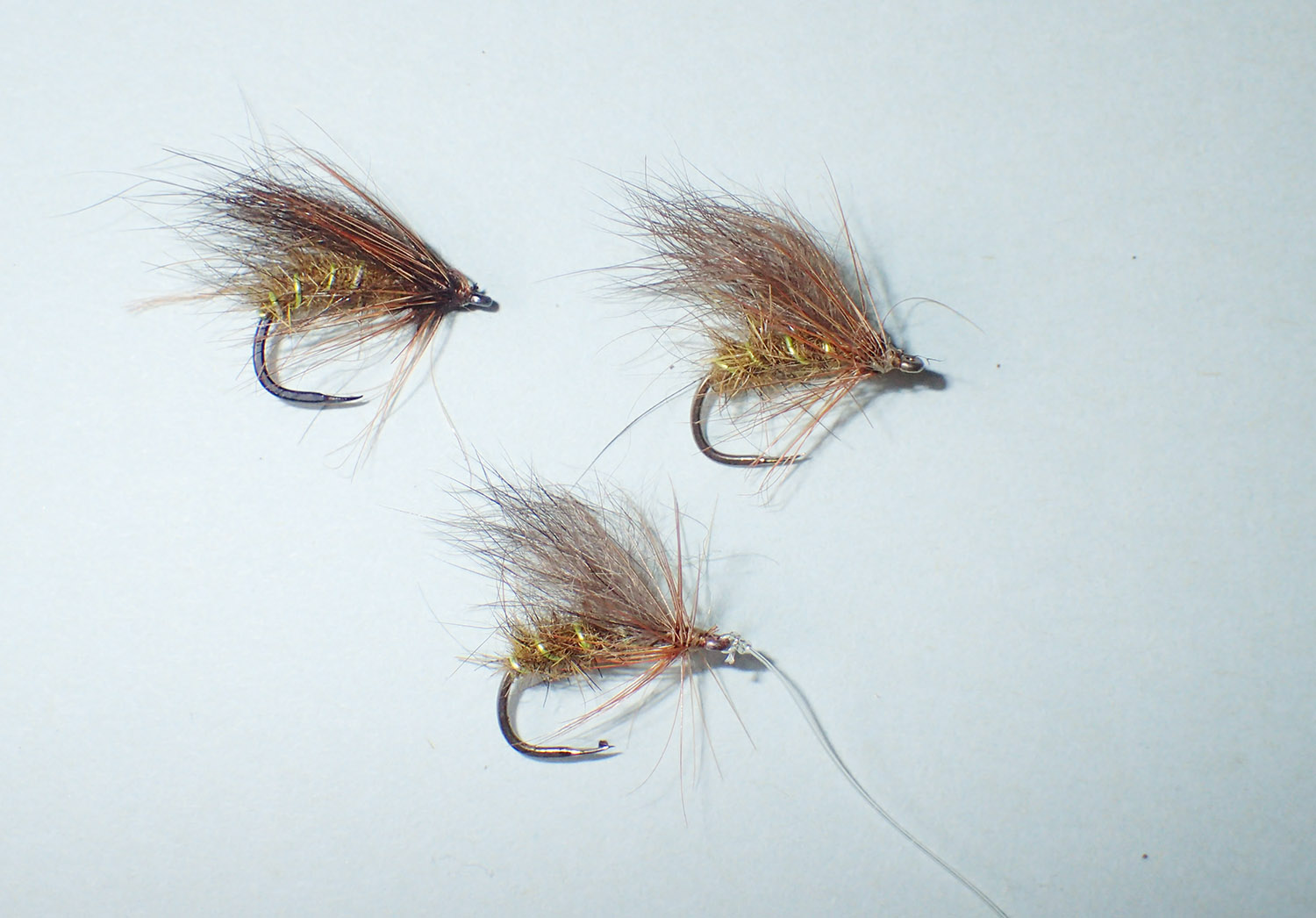
The Possum Caddis is a winged wet fly designed to imitate emerging net-spinning caddis pupae. It is tied on a #12 TMC 2499 SP hook
Caddis pupae are active swimmers so imitations fish well on the swing. The trick is to control the speed of the swinging flies by using appropriate casting angles and mends to imitate the swimming caddis pupae. Casts are usually directly across or across and slightly downstream.
Swinging soft hackles and winged wet flies outside of hatches can be successful in shallow riffles on some rivers, but for most lowland rivers in New Zealand I find small streamers more effective as prospecting patterns.
Trout Spey Gear for Hatches
Dry flies and emergers are usually fished on 1-3wt double handed rods in the USA, but I find a 5wt or 6wt 9-9.5 ft single hand rod more accurate and better able to handle large New Zealand trout. It is also easier to net fish with a single hand rod, especially when standing waist deep in water in the dark.
My favourite caddis hatch outfit is a 150 grain integrated Scientific Anglers Scandi Lite on a 5 wt 9 - 9.5 ft rod. The short 20 ft head means I can efficiently Spey cast from 30 feet to 60 feet, which is the most effective range for swing caddis hatches.
The head only version of the Scandi Lite casts a lot further on a thin mono running line, but casting too far usually crosses too many current lanes resulting in an ineffective swing as well as missed fish. The loop-to-loop connection sticking in the guides also becomes an issue during the inevitable frenetic hour of tussling with numerous big fish.
The 150 grain Scandi Lite was unfortunately discontinued in 2021. Luckily, Scientific Anglers introduced the Amplitude Creek Trout at about the same time. The Creek Trout has the profile of a compact integrated Scandi and makes a great single hand Spey line. The head length on the 160 grain 5wt version is 24 ft.
The 180 grain Scandi Lite is still available and is a great choice for 6 wt single hand rods.
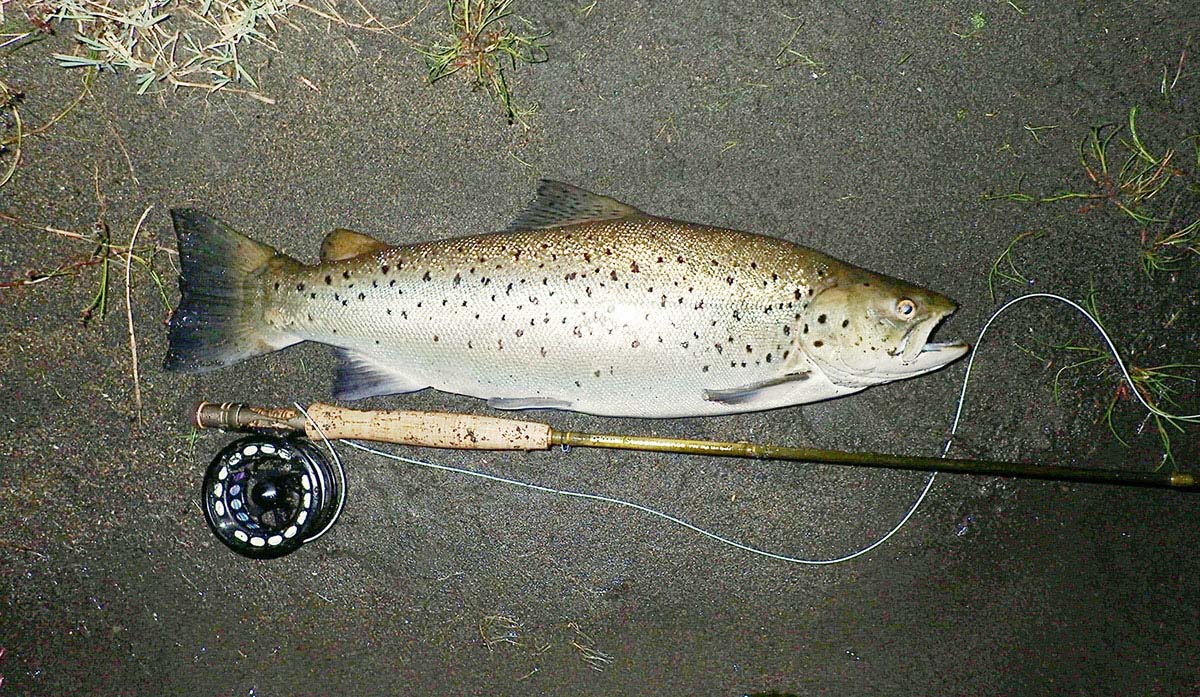
Another victim of my favourite caddis hatch outfit
Nymphs
Believe it or not, nymphs can be very effective fishing with Trout Spey gear on larger rivers - and I’m not talking about indicator nymphing.
Suitable flies are regular tungsten bead patterns in natural sizes (#16-14), e.g. hare’s ear and pheasant tail nymphs, and rubber leg patterns in larger sizes (#12-10).
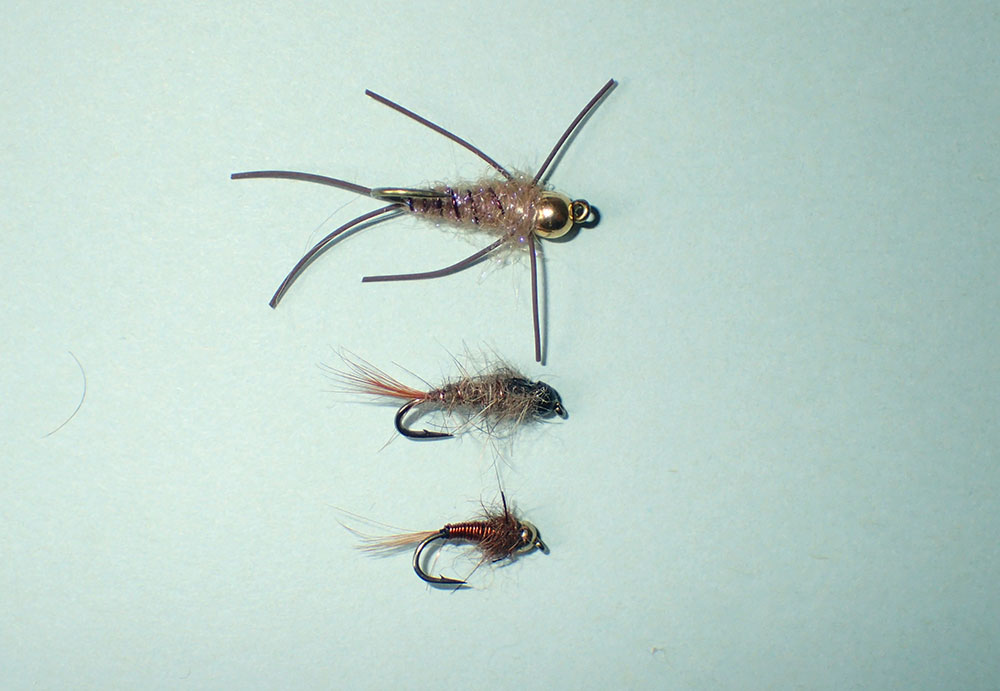
Examples of nymphs suitable for Spey gear. The smaller ones are fished as naturals, while the large rubber leg numbers are fished more like streamers.
There are three basic Spey techniques for nymphs:
1. Cast up-and-across and manage the line to achieve a tight-line drag-free drift, then at the end of the drift use suitable mends to control the speed of the swing.
2. Cast down-and-across and control the swing so the flies do not swim unnaturally fast.
3. Cast directly downstream so that the fly lands upstream of a rising fish, then pay out some running line so the fly sinks and then rises in front of the fish, as though it’s about to emerge.
A Scandi style line and a tapered leader of 10 to 15 ft usually works best for these techniques. When takes are felt the rod should only be lifted once the weight is on - striking prematurely results in missed fish.
Chris Dore, South Island trout guide and Spey guru, writes how swinging rubber leg patterns in #12 or #10 works wonders on days when trout are not that keen on standard streamers. Swinging large rubber leg nymphs can be done with a Skagit head and sink tip, so you don’t need to switch gear when replacing a streamer with a large nymph.
Streamers
Outside of hatches, streamers imitating baitfish or freshwater crayfish are what most Trout Spey anglers use. They are also the go when trout are smashing into schools of baitfish. Streamers are usually fished on Skagit heads and sink tips of varying sink rate.
There’s no doubt that streamers get more strikes when they’re made with mobile materials which wiggle when swung or stripped across current lanes.
One could easily get by with a box of woolly buggers in various colours and weights in sizes 10 to 6. I’ve never been overly successful with woolly buggers, though, and prefer my streamers to look more like local baitfish.
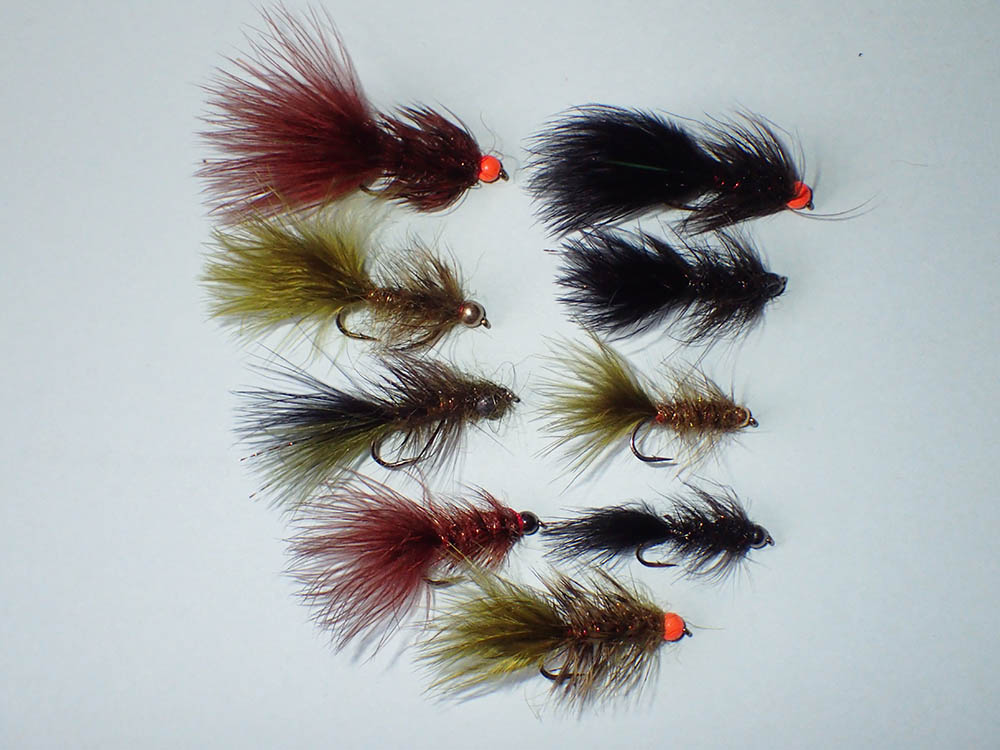
When it comes to streamers, you could get by with a box of woolly buggers in a range of sizes, colours and weights
Baitfish in New Zealand rivers are small by international standards, with bullies (a species of goby) and torrent fish most common. Other baitfish are native galaxids, such as inanga, and juvenile trout. My go-to streamers are based on strips of fur, usually rabbit for larger flies and pine squirrel for smaller ones.
The Trout Spey streamers I use can be grouped into those that are designed to be fished on the swing, and those designed to be stripped.
Flies for Swinging
The Swing Minnow is my go-to Trout Spey design. I only have to hold one in the current and observe its realistic minnow profile, side to side sway and lively wiggle to appreciate why trout go crazy for this pattern on the swing.
The Swing Minnow, tied in two sizes and several colours, imitates a range of New Zealand baitfish, e.g. bullies, torrent fish, smelt, baby trout and galaxiids. This design has been responsible for landing countless sea trout, Tongariro rainbows and browns, and works well during the day and at night.
Other flies commonly fished on the swing include standard rabbit streamers, mini-intruders and, of course, woolly buggers.
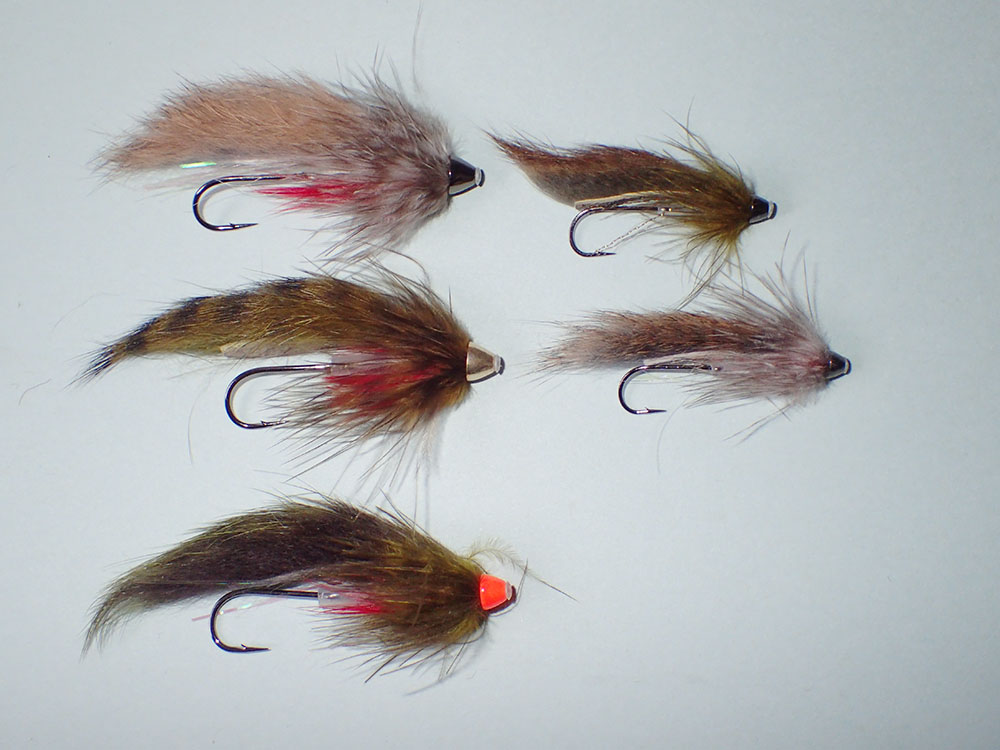
Swing minnow in two sizes and a range of effective colours
Techniques for swinging streamers
Swinging streamers is an effective method for covering large bodies of water and targeting spawning-run fish and sea trout. Streamers on the swing imitate smelt, baby trout and other baitfish living off the bottom.
There are three basic approaches for swinging streamers:
1. Cast down-and-across and then mend so the fly sinks, comes under tension, and begins to rise just ahead of where fish are expected to be sitting.
2. Cast across and use mends to present the fly swimming broadside to the fish and control the speed of the swing.
3. Cast down-and-across and swing the fly through wide areas of water containing fish. This can be done without animation, or with additional movement from tugging on the line or twitching the rod tip. Adding movement to the fly is effective for resident brown and rainbow trout during spring through autumn, while a standard slow swing works best at night and in winter for spawning run rainbows.
With these three strategies it pays to leave the fly in the hang-down position for a few seconds at the end of the swing, perhaps with the odd twitch, as any trout that has followed it usually now takes it.
Flies can be swung with single-handed or double-handed rods, although rods of 11-12 ft allow better line control on larger rivers. Longer rods and longer heads also require less stripping at the end of each swing.
On the Tongariro in summer and for medium sized rivers, I like an 11.3 ft 4wt rod. On the Tongariro in winter and for large rivers I favour a powerful 12 ft 5wt because it gives me more distance, better line control and it better handles fresh 5 pound and heavier fish in strong water.
I’m a great fan of Scientific Anglers Skagit Lite Intermediate heads for most situations, but will switch to a floating head and slower sinking tips when I need to swing in/on soft discoloured water or when swinging at night. When rivers are up and discoloured, the fish often move into slower shallow water nearer the bank.
Sink tips for the large Swing Minnow consist of 10 ft of Rio T-11 when I need to get down, and light Rio 3-D MOW tips in 3S/4S/5S and 5S/6S/7S when swinging slow or shallow water and fishing at night. I use 1X fluorocarbon for this pattern.
Sink tips for the small Swing Minnow, which I fish on the 4wt double hander or a 5wt 9-9.5ft single hander with 3X tippet, are usually #6 Rio Replacement tips in S6 and occasionally S3.
The same gear choices would apply for large and small woolly buggers.
Strip Streamers
Bullies and torrent fish live on the steam bed, amongst cobble, boulders and gravel. Hungry trout observe these fish shooting a few inches upward to grab food, move position or chase a competitor, then dive back to shelter. Flies imitating bullies and torrent fish should therefore dive and wiggle between strips, i.e. have bead or cone heads.
My favourite stripping patterns are the Strip Bully tied with Pine Squirrel in size #12 or #10 for small bullies, and a cone-head rabbit-strip trailer-hook version for larger sizes.
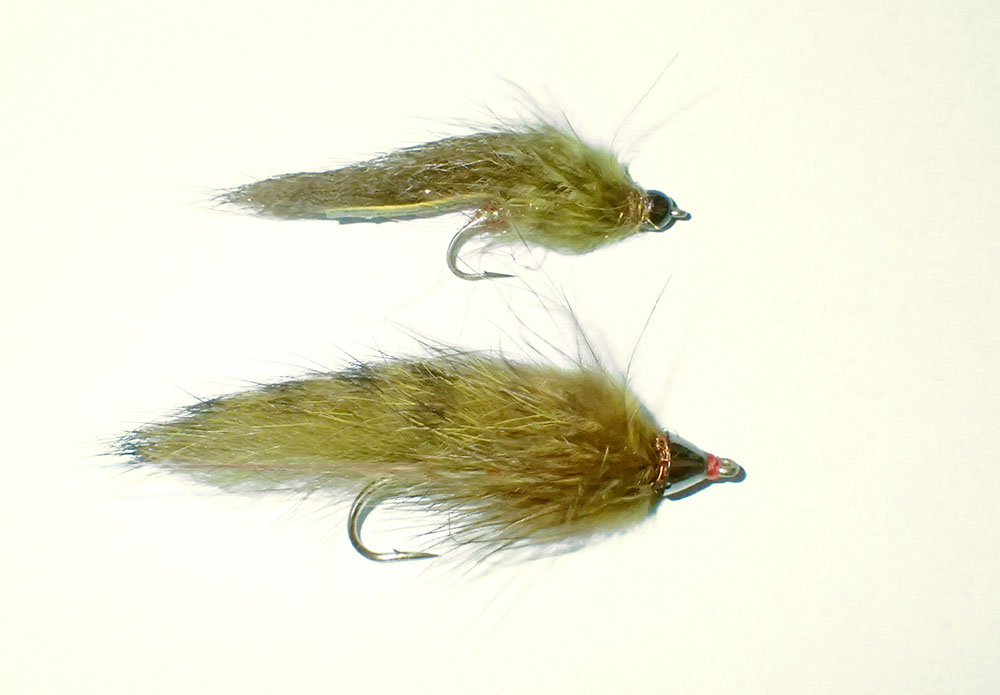
Small and large Strip Bullies
The trick to maximising wiggle, whilst reducing fouling, when tying the trailer hook version is to use a relatively short loop of 30lb braid to attach the trailer hook. Brown trout usually take stripped streamers toward the head, so the tailer hook should not be positioned at the very end of the fur strip. Using a robust hook, which allows multiple sharpening, such as the TMC 105, makes for a more durable fly.
Bead-head Woolly Buggers are also effective stripping streamers for New Zealand.
Three Effective Techniques for stripping streamers:
1. Cast directly across or up-and-across. Once the fly has had sufficient time to sink, retrieve it with sharp erratic strips, followed by short pauses to allow the fly to dive. This will work well on any water but is especially effective on larger pools with relatively slow flow.
2. Cast down-and-across so the streamer swings across fast water, then strip erratically upstream through the current seam on the inside.
3. Cast upstream or up-and-across and retrieve slightly faster than the current.
Gear for stripping streamers
For stripping streamers, I like to use 5-7wt 9-9.5 foot single hand rods with 11-12 ft tapered-belly Skagit heads and 9-10 ft sink tips. These outfits are accurate and allow one to fish and strip closer than with 11-12 ft two handed rods and longer heads. I can cast as far with my single hand outfits as with the double handers, albeit with more effort. Greater mending ability afforded by longer rods is not usually an advantage when stripping streamers.
SA Skagit Lite series in 150-240 grains work exceptionally well on single hand rods.
For more info on setting up single hand outfits for Trout Spey check out, 'Getting started with a single hand trout spey 9ft 5wt rod'.
What is Trout Spey |
|
| + | How it all began |
| + | What is Spey casting? |
| + | Fly lines |
| + | Sink Tips for Skagit Heads |
| + | Single versus two handed rods |
| + | Favourite Trout Spey outfits |
| + | Conclusions |
Single hand Trout Spey : Getting started with a 9 ft 5wt rod |
|
| + | Intro |
| + | Head design |
| + | Sink tips |
| + | Casting heavy sink tips |
| + | Running lines |
| + | Reels |
| + | Rods |
| + | Intermediate heads |
| + | Favourite outfits |
| + | Conclusions |
Single Hand Skagit - Science behind the magic |
|
| + | Where it all began |
| + | Head design |
| + | Sink tips |
| + | Casting heavy sink tips |
| + | Running lines |
| + | Reels |
| + | Rods |
| + | Intermediate heads |
| + | Favourite outfits |
| + | Conclusions |
Single hand Trout Spey : Getting started with a 9 ft 5wt rod |
|
| + | Getting started |
| + | Rods and Skagit heads |
| + | Sink tips for Skagit heads |
| + | Tippet for Skagit heads |
| + | |
| + | Hybrid heads |
| + | Floating tips for Skagit heads |
| + | Running lines |
| + | Cost effective approach |
| + | Learning to Spey cast |
| + | A final word |
